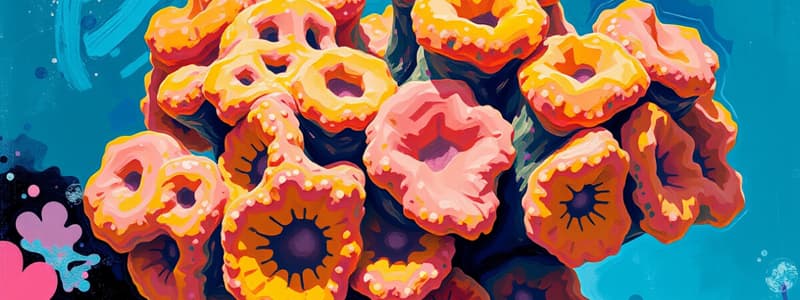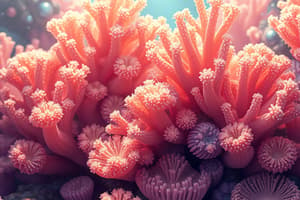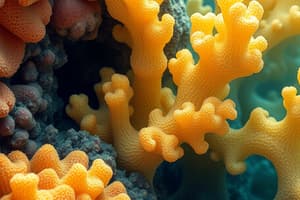Podcast
Questions and Answers
What is an osculum?
What is an osculum?
A large opening on a sponge through which filtered water is expelled.
What is a spicule?
What is a spicule?
Needlelike structures that give support and protection to the sponge body and prevent small animals from entering the sponge's internal cavity.
What is a choanocyte?
What is a choanocyte?
Collar cells that line the body cavity and have flagella that circulate and create water currents in sponges.
What is budding?
What is budding?
What defines Class Calcarea?
What defines Class Calcarea?
What is Class Hexactinellida known for?
What is Class Hexactinellida known for?
What is Class Demospongiae?
What is Class Demospongiae?
Describe the Ascon body form.
Describe the Ascon body form.
Describe the Sycon body form.
Describe the Sycon body form.
Describe the Leucon body form.
Describe the Leucon body form.
What are ostia?
What are ostia?
What are pinacocytes?
What are pinacocytes?
What is the mesohyl layer?
What is the mesohyl layer?
What are mesenchyme cells (amoebocytes)?
What are mesenchyme cells (amoebocytes)?
What is spongin?
What is spongin?
What is a gemmule?
What is a gemmule?
What is fragmentation?
What is fragmentation?
What does monoecious mean?
What does monoecious mean?
What is asexual reproduction?
What is asexual reproduction?
What is sexual reproduction?
What is sexual reproduction?
What is Phylum Porifera?
What is Phylum Porifera?
What is binomial nomenclature?
What is binomial nomenclature?
What is a cladogram?
What is a cladogram?
What is a domain in taxonomy?
What is a domain in taxonomy?
What is a phylum?
What is a phylum?
What is a class in taxonomy?
What is a class in taxonomy?
What is an order in taxonomy?
What is an order in taxonomy?
What is a genus?
What is a genus?
What is a species?
What is a species?
Flashcards are hidden until you start studying
Study Notes
Porifera Overview
- Porifera, commonly known as sponges, consist of simple multicellular organisms without true tissues or organs.
Key Structures
- Osculum: Large opening where filtered water exits the sponge.
- Spicule: Needlelike structures providing structural support and defense.
- Choanocyte: Collar cells that create water currents and trap food particles.
- Ostia: Small openings that allow water inflow into the sponge body.
- Pinacocytes: Protective outer layer cells; form ostia.
- Mesohyl Layer: Jelly-like interior layer containing mesenchyme cells for various functions.
- Mesenchyme Cells (Amoebocytes): Versatile cells involved in reproduction, structure secretion, and nutrient transport.
- Spongin: Collagen-based protein providing sponges with a flexible, compressible structure.
Body Forms
- Ascon Body Form: Simple structure with a central spongocoel and a single layer of choanocytes.
- Sycon Body Form: More complex with folded canals to increase surface area for water filtration.
- Leucon Body Form: Most complex structure with no central cavity, extensive canal networks, and numerous interconnected chambers.
Reproductive Strategies
- Budding: Asexual method where new individuals develop from the parent organism.
- Fragmentation: Asexual reproduction where a parent breaks apart to form new individuals.
- Gemmule: A resistant structure produced under harsh conditions, containing cells enclosed in a spicule-reinforced shell.
- Monoecious: Organisms possess both male and female reproductive organs.
- Asexual Reproduction: Produces genetically identical offspring from one parent.
- Sexual Reproduction: Involves genetic material from two parents, leading to genetically unique offspring.
Taxonomic Classification
- Class Calcarea: Sponges with calcium carbonate spicules.
- Class Hexactinellida: Known as glass sponges, characterized by silica spicules.
- Class Demospongiae: Largest sponge class with around 7,000 species featuring silica spicules and/or spongin.
- Phylum Porifera: Main classification for sponges within the animal kingdom.
Taxonomic Terminology
- Binomial Nomenclature: Dual Latin naming system for classifying organisms (e.g., Panthera leo).
- Cladogram: Diagrams illustrating the relationships between different organisms based on characteristics rather than evolutionary lineage.
- Domain: Top taxonomic rank, categorized as bacteria, archae, and eukarya.
- Phylum: Taxonomic category above class, used to group organisms.
- Class: Major taxonomic rank below phylum; consists of related orders.
- Order: Rank below class, used to group families with shared traits.
- Genus: Taxonomic rank above species, denoted by a capitalized Latin name (e.g., Leo).
- Species: Basic unit of classification, capable of interbreeding, denoted by a two-part Latin name (e.g., Homo sapiens).
Studying That Suits You
Use AI to generate personalized quizzes and flashcards to suit your learning preferences.




